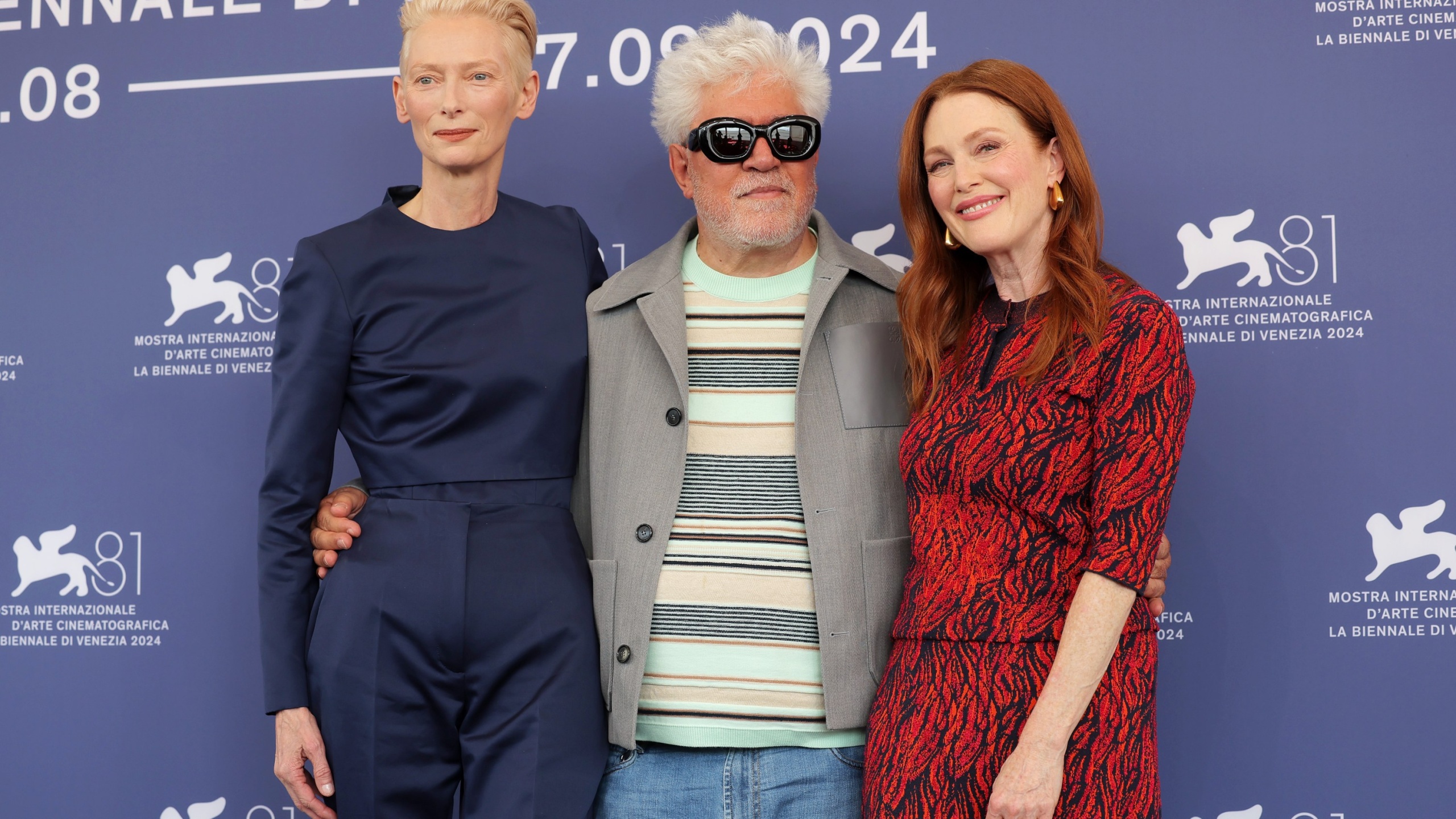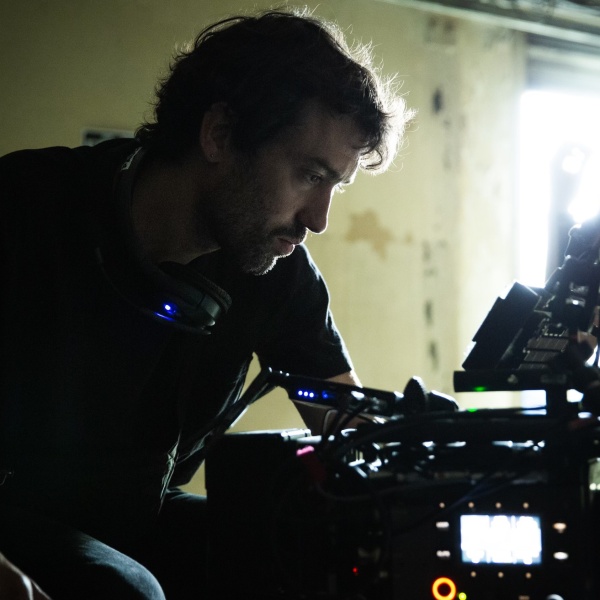Just because “The Room Next Door” is in English doesn’t make it any less of a Pedro Almodóvar movie. It’s visually sumptuous, as always, bathed in saturated colors. It’s an intense, heightened drama about one woman facing death (Tilda Swinton) while her close friend (Julianne Moore) supports her journey. The Spanish director was in control, as always, even when he occasionally lost an argument with his actresses.
The 75-year-old auteur was moved by the film‘s warm reception in Venice, where the jury awarded it the Golden Lion. But the fear of moving into a new language was always there.
Almodóvar had first considered shooting an English-language project with Meryl Streep, a version of “Julieta” (2016). He wrestled with how to adapt Canadian Alice Munro’s three short stories into English. He decided he’d rather set the story in Spain.
“If I would know what we all know now, about the secret of of Alice Munro and her daughter, and the silence,” he told IndieWire during a recent interview. “The tale then comes in a different more complex and richer way. I don’t judge Alice Munro for that, not at all. But for the tale, it becomes more interesting for me.”
His next English-language foray might have been “A Manual for Cleaning Women,” his script adaptation of five Lucia Berlin stories set to star actress-producer Cate Blanchett, but when she joined the Alfonso Cuarón series “Disclaimer,” Almodóvar decided not to wait a year to make a period film with multiple locations that would be tough on his fragile back.
Also, her company was producing the film, not his. “I was imagining me trying to control everything,” he said. “I thought it was too much for me.”
Instead, the director crafted two English-language shorts as a way to test the waters. Both were well-received: Swinton starred in the stylized Jean Cocteau adaptation “The Human Voice” (2020), while Ethan Hawke and Pedro Pascal played beautifully dressed cowboy lovers in “Strange Way of Life” (2023). “I made it two shorts in English to experiment by myself how I dealt with American actors,” he said, “and the experience was very good.”

Finally, everything came together for Almodóvar on “The Room Next Door,” his adaptation of a 2020 Sigrid Nunez novel, which his production company El Deseo produced on a small scale in the New York area. A contemporary two-hander starring the well-matched Swinton and Moore was something the director could handle.
“What it means, for the props, I could go to every shop,” he said, “to every magazine, to buy by myself. It was more handleable for me. It was under my terms, the movie. The two protagonists, they live in New York, so it should be in English. So that’s the reason that I do it in English. But it was very similar to the other 22 movies.”
When he read the novel, Almodóvar was hooked, he said, “about the situation that a friend is going to the hospital and sees her friend with a terminal disease.” The filmmaker started out fashioning a possible short, then realized it was a feature. “From the moment that I got past that point of the proposal, I never went back to the novel,” he said. “From there, I started to imagine my own story, and I had that epiphany of the moment of the snow falling. And so from that moment on, I just followed my own instincts about the story.”
He did use the John Turturro character to voice many of Nunez’s environmental concerns “and about how dangerous is the neoliberalism linked with the far right,” Almodóvar said. “It was important to give that message in a country that will have an election soon.”
Lately the filmmaker has developed what he calls a more “austere” style for “Julieta” and his auto-fiction, “Pain and Glory,” starring Antonio Banderas as a director with a bad back. “The look is more restrained, contained,” he said. “I didn’t want to make melodramatic sequences, or be very sentimentalist. So, when you speak of mortality, it’s easy to fall towards melodrama. I didn’t want to lean in that direction. I wanted to remain contained and austere.”
He added, “This is something that the actresses helped me with, the way that they acted supported my vision for the film. Now, it was not true for the colors. I did want the colors to be alive and express vitality. Unlike some of my other films, it was just flashes of color. So it might have been a vase, or a painting in the background. Still, [Tilda Swinton] was an extravagant character, which means you can put anything on that character. And she makes it feel real and tangible.”
One day, Swinton showed up wearing a big, baggy sweater she bought that was yellow and red. “I loved it,” said Almodóvar, “so she wears it in that scene where they’re watching Buster Keaton.”
The red door was important, he said, “because this is a film about death. In many ways, it was a dramatic gesture pointing to Japanese culture, where red often signifies someone who’s going to die. They will wear a red garment. And vibrant colors are part of my authorial signature, and even though I wanted to be contained in the narrative visually, I will always turn to color.”
He continued, “I didn’t want the story to be necessarily a sad story or a boring story, I wanted death to also be vibrant and alive. It is part of Tilda’s character’s vitality that she decides to take death into her own hands. I wanted this vitality to be visible, which is why they’re in a beautiful place, surrounded by nature, surrounded by colorful furniture with the reds and the greens. For me, it was a way of transposing the character’s own vitality into the visual register of the film.”

As for the language, the filmmaker has always used a formal form of Spanish, not colloquial, not naturalistic. He had one translator recommended by Luca Guadagnino, and another American writer. “I was very concerned about the English,” said Almodóvar. “We wanted an English that should sound American. My films have never been naturalistic. I have never aspired to the mumbling or babbling or pausing or some of those things that happen in regular language. I like my language to be concentrated and precise. In Spanish, it has worked well.”
During the shoot, both actresses argued with their director about some of the lines. “Sometimes they told me, ‘Pedro, I think this line, it will sound much better in this way,’” he said, “basically more Julianne than Tilda. They would say to me, ‘This particular phrase, the way that you’ve written, it sounds a little too literary. And It’s not colloquial.’ Even though I explain to them that I don’t use colloquial language, they insisted. I listened to them, and I did change a couple of phrases. I gave up, because, of course, I couldn’t compare my English with their English. And I finally had to give in and change the language a bit.”
The director praises his actresses for pulling off the dialogue. “It’s difficult what Julianne had to do, which is looking at someone, listening,” he said. “Tilda talks a lot and the other one is listening. When I made a close-up of Tilda, I made also the corresponding close-up of Julianne, but not talking, in silence and looking, and you have to see in her eyes, the words of the other. So they made an incredible work.”

Next up: While he’s promoting his new film, the filmmaker is also finessing the script of his next Spanish movie, “Bitter Christmas,” set in Spain. “It will be a tragic comedy about gender,” he said. “There are moments of comedy and moments of tragedy.”
His development process involves keeping many stories simmering on various burners, some low, some high, until a project is ready. For one, “Talk to Her” took ten years to finish.
“I need to be in contact with new stories,” he said. “They’re like fresh air for me. So that’s why in this moment, I am taking notes about new things that I would like to make in the future. You write, you finish, you are not satisfied, and wait, and keep on working. So I know sometimes when I have to wait. It’s like a factory where things are in different stages of development. Sometimes they’re my primary source of entertainment. If I have a Sunday where I have nothing to do, I will pull up a story that I haven’t touched in two years, and suddenly I discover something new about it. This, of course, means that I only live to write and make films, which is also true.”
Sony Pictures Classics will release “The Room Next Door” in theaters on Tuesday, December 24.




